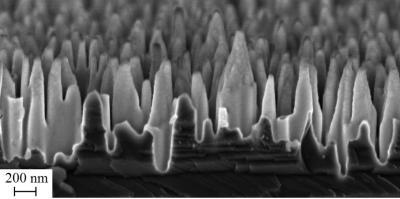Scientists at Aalto University, Finland, have demonstrated results that show a huge improvement in the light absorption and the surface passivation on highly absorbing silicon nanostructures. This has been achieved by applying atomic layer coating. The results advance the development of devices that require high sensitivity light response such as high efficiency solar cells.
This method provides extremely good surface passivation. Simultaneously, it reduces the reflectance further at all wavelengths. These results are very promising considering the use of black silicon (b-Si) surfaces on solar cells to increase the efficiency to completely new levels, tells Päivikki Repo, a researcher at Aalto University.

Black silicon gets its name from its color.
(Photo Credit: Paivikki Repo)
More effective surface passivation methods than those used in the past have been needed to make black silicon a viable material for commercial applications. Good surface passivation is crucial in photonic applications such as solar cells. So far, the poor charge carrier transport properties attributed to nanostructured surfaces have been more detrimental for the final device operation than the gain obtained from the reduced reflectance.
Black silicon can also be used in other technologies than solar cells. Numerous applications suggested for b-Si include drug analysis.
Black silicon (b-Si) has been a subject of great interest in various fields including photovoltaics for its ability to reduce the surface reflectance even below 1 per cent. However, many b-Si applications - especially solar cells - suffer from increased surface recombination resulting in poor spectral response. This is particularly problematic at short wavelengths.
Source: Aalto University